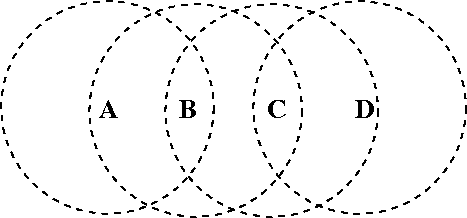- We consider a token ring protocol
operating on a ring network with a
data rate of
10 Mbps.
There are N = 10 nodes connected to the token ring network.
A node is allowed to transmit 1 packet when it receives the token.
When a node receives the token and transmits a message, the message must return back to the sending node and then the node will pass the token to the next node in the ring.
We assume that all messages have the same length and each message is 1000 bytes (= 8000 bits) long.
The distance between any 2 nodes is the same and it takes 1.0 msec (milli sec) for a message to travel to the next node in the token ring.
We define the token rotation time Trot to be the time between 2 consecutive arrivals of the token at the same node.
For example:
- Suppose node 1
received the token
at time T1
Node 1 could now transmit a message or if node 1 has no message to transmit, it will pass the token to the next node
- Then later,
at time T2,
node 1 received
the token again.
- Then the token rotation time is
equal to:
Trot = T2 − T1
Questions:
- What is the minimum value
of the token rotation time
in this token ring network ? (10 pts)
- What is the maximum value
of the token rotation time
in this token ring network ? (10 pts)
- Suppose node 1
received the token
at time T1
- Consider the variables in
a node in
a token bus network:
ID = 4444 predeccessor = 5678 successor = 1234
Suppose the node 4444 wish to invite other nodes to join the token bus network
Question:
- What control message will
the node 4444 transmit: (5 pts)
- Give the range of
node IDs that
are invited: (5 pts)
Suppose this node receives the token frame from the node 5555
Questions:
- Give a
scenario where
the node 4444 can
receive
a token from
node 5555
(that is not
its predecessor) (5 pts)
- Show the values of the
variables of this
node
after it has processed the
token frame: (5 pts)
ID = 4444 predeccessor = _________ successor = _________
Use the original values in the node's variables to answer this question
Suppose this node receives a Who_follows(5678) from node 9999
Questions:
- Give a
scenario where the
node 4444 can receive
such a control frame (5 pts)
- What is the response of
node 4444 to this
control message ? (5 pts)
- What control message will
the node 4444 transmit: (5 pts)
- Consider the
following wireless network
with 4 nodes
(A, B, C and D)

Questions:
- List the
hidden node(s) of
each node below: (10 pts)
Hidden node for A: ____________ Hidden node for B: ____________ Hidden node for C: ____________ Hidden node for D: ____________
- List the
exposed node(s) of
each node below: (10 pts)
Hidden node for A: _____________ Hidden node for B: _____________ Hidden node for C: _____________ Hidden node for D: _____________
- List the
hidden node(s) of
each node below: (10 pts)
- Suppose 2 wireless nodes A and B uses
the following chips:
chip of A = 1010111 chip of B = 1101000The nodes received the following transmissions:
A B --------------------------------- 1111111 _______ _______ 1000000 _______ _______ 0111111 _______ _______ 0000000 _______ _______Write in the table above the bit value that each node will assign to each transmission (10 pts)
- Let A and B be two
IEEE 802.11 hosts attempting to transmit
on an wireless network.
Each host has a steady queue of frames
ready to send.
A's frames will be numbered as A1, A2 and so on, and B's frames will be numbered as B1, B2 and so on.
Suppose the IEEE 802.11 MAC algorithm using this value for the initial back off window size:
CWmin = 15 (i.e.: initial choice of random numbers from [0 .. 15])Suppose A and B simultaneously (= at the same time) attempt to send frame 1 and the transmissions collide (= did not receive an ACK frame).
Assumes that A chooses backoff time 2×T (i.e., A picked the random number 2) and B chooses backoff time 14×T.
According to the DCF protocol (see: click here ), A will wins the race and transmits its first frame A1 successfully.
Notice that when A starts transmitting its first frame A1, the node B will pause its count down (see the DCF protocol: click here ) !!!
When node A finishes transmitting the frame A1, the node A first perform a back off (while B will resume the count down)
Therefore, nodes A and B will be competing compete to transmit their frames.
Questions:
- Find the probability
that A will win
the second backoff race
(10 pts)
Probab(A wins) = ___________________ - Find the probability
that B will win
the second backoff race
(10 pts)
Probab(B wins) = ______________
- Find the probability
that A will win
the second backoff race
(10 pts)